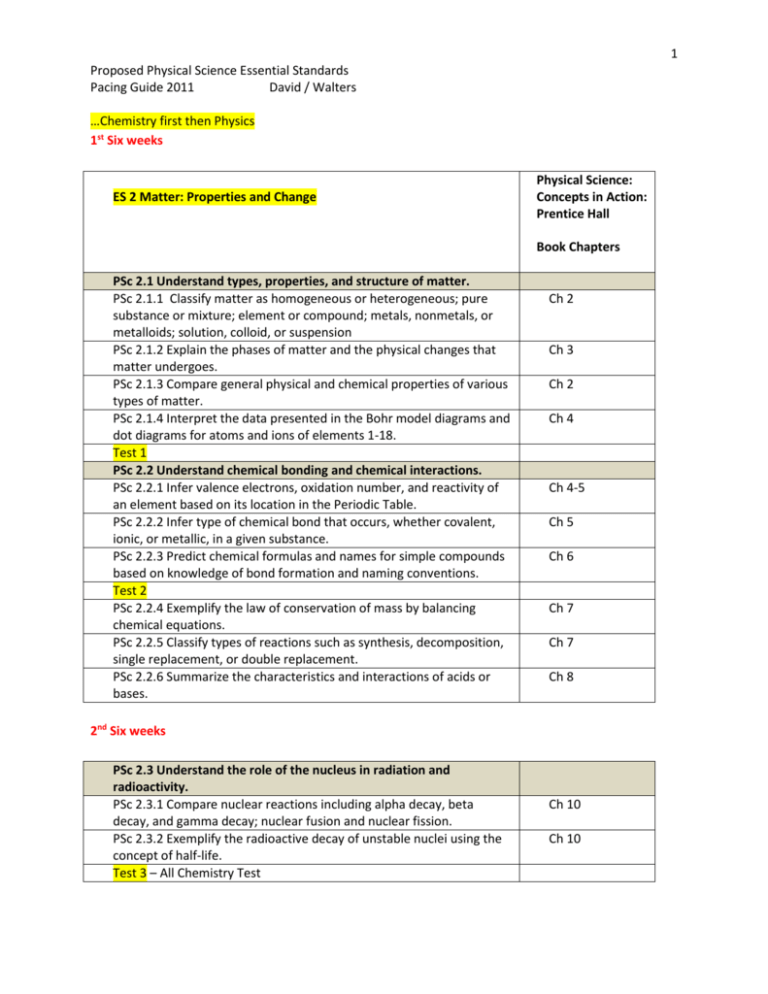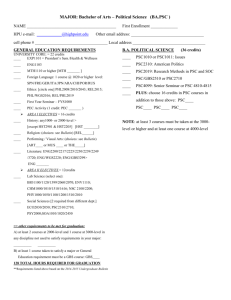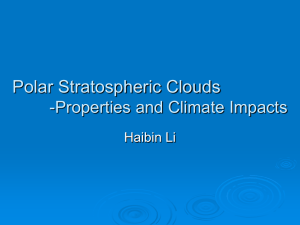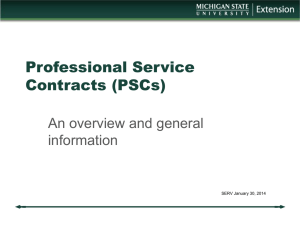Proposed Physical Science Essential Standards Pacing Guide 2011
advertisement

1 Proposed Physical Science Essential Standards Pacing Guide 2011 David / Walters …Chemistry first then Physics 1st Six weeks ES 2 Matter: Properties and Change Physical Science: Concepts in Action: Prentice Hall Book Chapters PSc 2.1 Understand types, properties, and structure of matter. PSc 2.1.1 Classify matter as homogeneous or heterogeneous; pure substance or mixture; element or compound; metals, nonmetals, or metalloids; solution, colloid, or suspension PSc 2.1.2 Explain the phases of matter and the physical changes that matter undergoes. PSc 2.1.3 Compare general physical and chemical properties of various types of matter. PSc 2.1.4 Interpret the data presented in the Bohr model diagrams and dot diagrams for atoms and ions of elements 1-18. Test 1 PSc 2.2 Understand chemical bonding and chemical interactions. PSc 2.2.1 Infer valence electrons, oxidation number, and reactivity of an element based on its location in the Periodic Table. PSc 2.2.2 Infer type of chemical bond that occurs, whether covalent, ionic, or metallic, in a given substance. PSc 2.2.3 Predict chemical formulas and names for simple compounds based on knowledge of bond formation and naming conventions. Test 2 PSc 2.2.4 Exemplify the law of conservation of mass by balancing chemical equations. PSc 2.2.5 Classify types of reactions such as synthesis, decomposition, single replacement, or double replacement. PSc 2.2.6 Summarize the characteristics and interactions of acids or bases. Ch 2 Ch 3 Ch 2 Ch 4 Ch 4-5 Ch 5 Ch 6 Ch 7 Ch 7 Ch 8 2nd Six weeks PSc 2.3 Understand the role of the nucleus in radiation and radioactivity. PSc 2.3.1 Compare nuclear reactions including alpha decay, beta decay, and gamma decay; nuclear fusion and nuclear fission. PSc 2.3.2 Exemplify the radioactive decay of unstable nuclei using the concept of half-life. Test 3 – All Chemistry Test Ch 10 Ch 10 2 Proposed Physical Science Essential Standards Pacing Guide 2011 David / Walters ES 1 Forces and Motion PSc 1.1 Understand motion in terms of speed, velocity, acceleration, and momentum PSc 1.1.1 Explain motion in terms of frame of reference, distance, and displacement. PSc 1.1.2 Compare speed, velocity, acceleration, and momentum using investigations, graphing, scalar quantities, and vector quantities PSc 1.2 Understand the relationship between forces and motion. PSc 1.2.1 Explain how gravitational force affects the weight of an object and the velocity of an object in freefall. PSc 1.2.2 Classify frictional forces into one of four types: static, sliding, rolling, and fluid. PSc 1.2.3 Explain Newton’s three laws of motion. Test 4 Ch 11 Ch 11 Ch 12 Ch 12 Ch 12 ES 3 Energy: Conservation and Transfer PSc 3.1 Understand types of energy, conservation of energy and energy transfer. PSc 3.1.1 Explain thermal energy and its transfer. PSc 3.1.2 Explain the law of conservation of energy in a mechanical system in terms of kinetic energy, potential energy and heat. PSc 3.1.3 Explain work in terms of the relationship among the force applied to an object, the resulting displacement of the object, and the energy transferred to an object. Test 5 Ch 16 Ch 15 Ch 15 3rd Six Weeks PSc 3.1 Understand types of energy, conservation of energy and energy transfer. PSc 3.1.4 Explain the relationship among work, power, and simple machines both qualitatively and quantitatively. PSc 3.2 Understand the nature of waves. PSc 3.2.1 Explain the relationships among wave frequency, wave period, wave velocity, amplitude, and wavelength through calculation and investigation. PSc 3.2.2 Compare waves (mechanical, electromagnetic, and surface) using their characteristics. PSc 3.2.3 Classify waves as transverse or compressional (longitudinal). PSc 3.2.4 Illustrate the wave interactions of reflection, refraction, diffraction, and interference. Test 6 Ch 14 Ch 17 Ch 17-18 Ch 17 Ch 18 3 Proposed Physical Science Essential Standards Pacing Guide 2011 David / Walters PSc 3.3 Understand electricity and magnetism and their relationship. PSc 3.3.1 Summarize static and current electricity. PSc 3.3.2 Explain simple series and parallel DC circuits in terms of Ohm’s law. PSc 3.3.3 Explain how current is affected by changes in composition, length, temperature, and diameter of wire. PSc 3.3.4 Explain magnetism in terms of domains, interactions of poles, and magnetic fields. Test 7 – All Physics Test Review for Final Exam Ch 20 Ch 20 Ch 20 Ch 21 NB: - AY 2011-12 transitioning from NCSCOS (NC Standard Course of Study) to Essential Standards Textbook is available as a class set. Students will be asked to create online accounts to be able to access the electronic version of the book from the publisher’s website.







